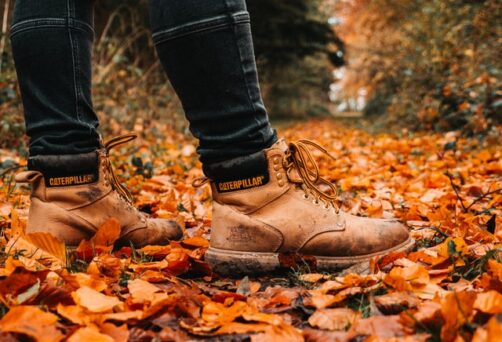
November began true to form. With copious amounts of rain. Combine rain and fallen leaves and what do you get? Slippery paths and pavements which can sometimes feel tricky to navigate safely. So how can you prevent falling in winter and avoid slips, trips and falls?
Whilst it is right to be cautious about going out when it’s slippery and wet, especially if you have fallen before or have worries that you might, it is essential that you remain active during the wet and winter months, so you maintain your general fitness, your mood and your bone health.
There are simple steps (notice the pun?!) you can take to prevent slips, trips and falls when out for a walk in adverse conditions. Here are some of the most important ones:
It may sound pretty obvious, but it’s amazing how many people we see wearing inappropriate footwear when we’re out and about. Wear walking shoes/boots which are laced properly (every time) and make sure they have good, grippy soles. Some decent waterproofs might be useful too!
Ideally, one which is maintained/cleared regularly. It might mean taking a short drive or bus journey to get you to a safer spot but it’d be worth it in the long run as you'll prevent falling over unfamiliar terrain.
If you can't see slips, trips and falls are going to be inevitable. Make sure it is light enough so you can see underfoot and ahead of you. If you have evening dog-walking duties, pick a route that is well lit with street lamps and consider wearing a head torch. This will enable you to walk ‘hands-free’ and reach out should you stumble or lose balance.
Trekking poles can also be very useful equipment to prevent falling and are used regularly by keen walkers. They also help us maintain a good walking pattern, which makes us more efficient when we walk. Oh, and they are not at all ageing, unlike some peoples’ perception of using sticks.
Most of us have these with us these days but do remember to have it charged and switched on. If you end up falling, get lost, or are stuck it will prove to be a useful way of getting help.
This way your body is likely to respond more quickly should you end up falling. Your reaction times will be better if you’re well-practised. For more ideas, check out the Plus Health website.
When you really don’t feel like going out rather than not exercising at all there is plenty you can do around the house. Check out our blog for more ideas on this as well as our video titled ‘exercises to avoid becoming chair-shaped’.
How confident you feel exercising outdoors can often be linked to previous experiences or worries about certain aspects of your health. If you have fallen previously or feel unsteady, ask your GP to refer you for a ‘falls assessment’. This MOT style NHS assessment can help identify factors that may increase your susceptibility to falling and sustaining an injury if you do. Sometimes just getting your eyes checked over can make all the difference. Oh, and if you haven’t had your bone health assessed yet, ask for that too. Having the right treatment (where needed) can help minimise the risk of breaking a bone, which in turn helps you retain your independence and do the things you love.
You might like to check out our blog about osteoporosis and bone health for more information.